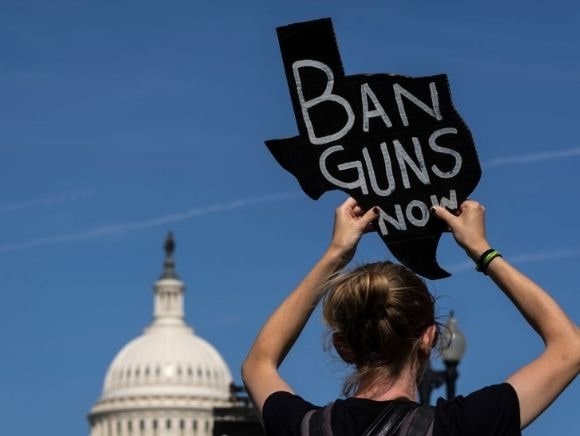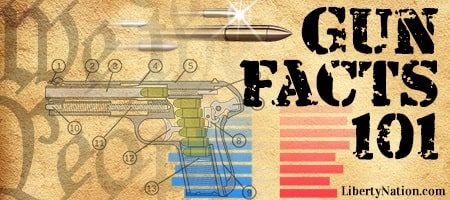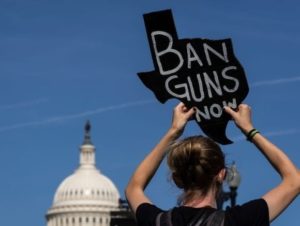
(Photo by Drew Angerer/Getty Images)
Editor’s Note: With so much misinformation and confusion in the gun debate, Liberty Nation presents the second in a three-part series examining the facts on firearms. In this segment, we ask and answer, what is “high caliber”?
Shortly after the shooting at Robb Elementary School in Uvalde, TX, President Joe Biden said some ridiculous things about 9 mm weapons and implied that they should be banned. At one point, he declared that a 9 mm bullet “blows the lung out of the body” when it hits someone in the chest. He then called the 9 mm a “high-caliber” weapon and claimed there was no good reason for civilians to own one. But what is a high-caliber weapon, anyway?
For most people with enough cognitive function to reliably tie their own shoes, that lung-removing bullet bit was obvious garbage. However, what he said next might slide under the radar and mislead even intelligent and sensible people who just aren’t familiar with firearm lingo. “So, the idea of these high-caliber weapons is, uh, there’s simply no rational basis for it in terms of self-protection, hunting,” Biden concluded.
A High-Caliber Primer on Gun Terms
A glance at thesaurus.com supplies all the synonyms for high caliber anyone could ever need: admirable, exceptional, first-rate, remarkable, etc. In short, if something is of high caliber, that means it’s of high quality. If a gun owner shows you a “high-caliber weapon,” that probably means it’s a favorite – regardless of what caliber bullet it fires. Joking aside, the origin of Biden’s “high-caliber” confusion seems most likely to have originated from a misunderstanding of two terms one might hear in firearm discussions: large caliber and high powered.
In the gun world, caliber refers to the diameter of a bullet. A 9 mm pistol shoots a bullet with a diameter of 9 mm, which is also 0.355 inches. The larger the diameter of the bullet, the larger its caliber and that of the gun. So, a .45 ACP, which has a bullet diameter of 0.452 inches (11.5 mm), is a larger caliber round and pistol than a 9 mm. Sometimes, people refer to larger caliber firearms as “large bore,” and that just means it takes a bigger bullet.

The other descriptor is most often applied to rifles. After a shooting, one will often hear that the AR-15 is a high-powered rifle. The definition here is considerably harder to pin down than that of caliber. Generally, the faster a bullet is traveling, the higher power it’s said to have. Caliber certainly plays a part here as well. If two differently sized bullets are flying toward a target at the same speed, the bigger one is almost certainly going to have more destructive power when it hits. Consider the AR-15 and the Remington Model 7400 from Firearm Facts and Misconceptions Part I. That .30-06 is a much higher powered rifle than the AR.
It’s All Relative
Now you might be thinking to yourself, “Well, that’s awfully vague.” If so, you’re absolutely correct. There is no full-stop point at which a firearm becomes either large caliber or high powered. As you might have guessed, either in reading the definitions themselves or just by looking at the words used, it’s all relative.
Is the 9 mm a large-caliber pistol? Yes – compared to a small handful of other, lighter options, like the .22 LR, the .22 Short, and the .380 Auto. But it’s considered a small-caliber pistol by the majority of shooters – and many who won’t trust their lives to anything smaller. Compared to the other popular rounds — like the aforementioned .45 ACP, or a .40 S&W, .44 Special, or .44 Magnum — it’s actually a small-caliber weapon.

(Photo by Drew Angerer/Getty Images)
Is an AR-15 a high-powered rifle? Yes – when compared to something like a .22 rifle or even most handguns. But compared to the vast majority of other rifles – regardless of fancy features and semi-automatic action – the answer is a resounding “no.” The majority of rifle calibers are actually larger than the 0.223 inch or 5.56 mm bullet, and those bigger bullets are moving just as fast. Many have a higher speed and longer range as well as a bigger, heavier bullet.
But higher power doesn’t just mean larger caliber. The 9 mm handgun round has a larger caliber than the 5.56 mm, and the .22 LR has the same diameter. But what both the 9 mm and the .22 LR don’t have that the 5.56 mm rifle round does is length – which means both a heavier bullet and more explosive force pushing it toward the target. Bigger bullets make bigger holes – but faster bullets tend to go farther and do more damage when they hit because there’s more energy to be transferred to the target.
So, yes, a 9 mm can be considered a large-caliber pistol if you’re comparing it to a smaller gun – but few outside of Biden’s ilk would ever consider it one. And, no, it won’t blow your lung right out of your body. Large-caliber handguns tend to be the .45s and .44s – neither of which the president is currently talking about banning. But unlike the 9mm, neither of those two options is the most common handgun in the nation, either. Should he manage to ban 9 mm – especially using “high-caliber” rhetoric – you can rest assured those bigger options will soon follow.
Remember to check out the web’s best conservative news aggregator
Whatfinger.com — the #1 Alternative to the Drudge

